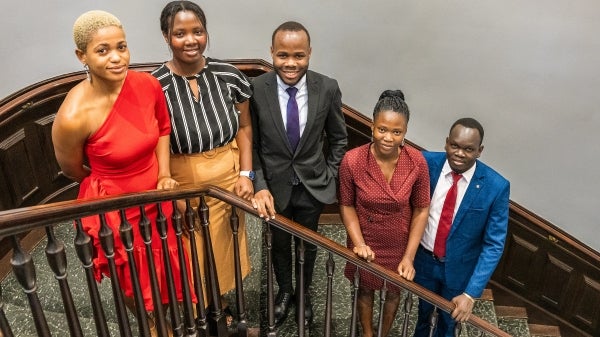It’s cool when everybody knows your name, but if you’re running a big company, fame can have a down side.
A new theoretical paper by an Arizona State University professor looks at why CEOs who become celebrities frequently see a drop in their company’s performance.
Jonathan Bundy, an assistant professor of management in the W. P. Carey School of Business, said he and his fellow researchersBundy’s co-authors on the paper are Donald C. Hambrick and Timothy G. Pollack of Penn State University and Jeffrey B. Lovelace of the University of Virginia. The research will be published in “The Academy of Management Review.” wanted to explore the relationship between celebrity and a company downturn.
“We’re trying to solve this idea of why is it a negative relationship, because multiple empirical papers have found that celebrity is actually bad for performance in the long run,” Bundy said.
So they developed a model and theorized that CEOs are not only held up as celebrities, they’re typically cast into one of four “archetypes” — creator, transformer, rebel and savior. The leaders then begin to internalize the roles they’ve been assigned and that can lead to faulty decision-making.
Bundy and his team looked at previous research, which has shown:
• CEOs can become popular regardless of how well they’ve performed.
• Celebrity brings benefits to CEOs, such as higher salaries and insulation from dismissal, and those benefits spill over to the top management team — whose chances of becoming CEOs at other companies are increased.
• The party isn’t everlasting. The paper cites two studies showing that when popular CEOs win major awards, their companies then suffer a negative performance trend in subsequent years.
Bundy and the team modeled four common “archetypes” in the way that popular CEOs were portrayed by journalists.
“Creators” are acclaimed for founding or growing a company and possibly even creating a new market category or industry. They’re described as visionaries and risk-takers. Examples include Bill Gates of Microsoft, Howard Schultz of Starbucks, Mark Zuckerberg of Facebook and Elon Musk of Tesla and SpaceX.
“Transformers” are heroes who save firms from failure. They’re portrayed as able to predict problems that others do not see. Examples include Jack Welch at GE, Ursula Burns at Xerox and Indra Nooyi at Pepsico.
“Rebels” are CEOs who defy industry conventions. They’re considered to be courageous rule-breakers. Examples include John Legere of T-Mobile, Tony Hsieh of Zappos and Brian Chesky of Airbnb.
“Saviors” turn around companies in decline, and the media uses themes such as accountability, toughness and discipline. Examples include Lee Iacocca of Chrysler, Carlos Ghosn of Nissan and Jamie Dimon of Bank One (now JP Morgan Chase).
Jonathan Bundy is an assistant professor of management in the W. P. Carey School of Business.
The paper refers to these archetypes as “shackles” because, after attaining praise, the company chiefs often not only persist in the behaviors of each type but often will double down on them — sometimes unwisely. With their confidence fueled by fame, the CEOs base more decisions on intuition rather than careful judgment, exacerbated by a lack of external control.
“With some of these cognitive pressures, and particularly the idea of typecasting, you have to live up to that greatness and when you don’t, it leads to exaggerating behaviors,” Bundy said. “You do what you did but in more extreme ways.”
Travis Kalanick is an example, Bundy said. Kalanick’s unrestrained methods brought big investors and attention to Uber, but he was eventually forced out of the CEO job after reports surfaced of a problematic culture at the company, which generated a lot of negative publicity.
“He came in and did great things in very counter-normative ways. But now people are questioning whether that’s good,” said Bundy, whose research focuses on corporate reputation.
And fame can produce a stronger backlash to wrongdoing.
“When you become famous or you gain a lot of status, people give you a lot of deference. What that does is it increases the expectations and when you violate those expectations, the punishment tends to be more severe.”
The message to corporations is: “proceed with caution.”
“The idea is that celebrity can bring a lot of short-term benefits. It brings attention to your firm and it serves a marketing function. But the whole idea is that celebrity restricts your ability to think broadly,” he said. “Over decades, and a career, that has a negative effect because you can’t anticipate change or be reactive to innovation.”
And if a company sees its CEO on a trajectory toward fame?
“You would want to make sure there is a devil’s advocate in the CEO suite who’s challenging that,” he said.
Bundy and his fellow authors are now taking the project a step further by testing the idea empirically. They’re looking at coverage of CEOs in newspaper, magazine and broadcast stories, and also examining social-media data.
“Now we’re trying to predict who becomes a celebrity," he said. "Who gets the most coverage and the most positive coverage?”
And what about Oprah and Jay Z? The team would eventually like to consider people who were celebrities before they became CEOs.
“They may have their own really interesting effect on their businesses,” he said.
Top photo courtesy of Pixabay.com.
More Business and entrepreneurship

Cohort of Mastercard Foundation Scholars poised to become AI leaders in Africa
Arizona State University is celebrating a significant milestone in expanding the university’s global access mission by welcoming the newest cohort of Mastercard Foundation Scholars, who will…

Networking event turns pitches into partnerships
Perfect timing, quick decisions and electrifying energy are vital aspects of both startup ventures and auctions. In an environment where every moment matters, everyone is searching for the deal that…

Thunderbird at ASU, W. P. Carey School team up on concurrent master's degrees
Students are now able to take advantage of two world-class schools at Arizona State University, at the same time. The Thunderbird School of Global Management and W. P. Carey School of Business…

